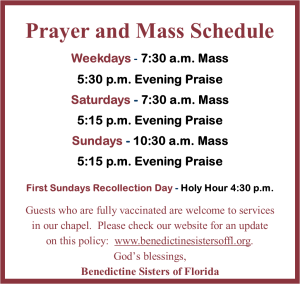Each year in Advent, I look forward to the singing of the O Antiphons. I especially like that we use the ancient chant tones and Latin form of address. Having once heard the monastic version, I’d feel deprived if we, like in the parishes, only sang the Antiphon as the Gospel Acclamation. Now in this final week of Advent, this monastic custom fixes our attention on the messianic promises proclaimed by the ancient prophets of Israel, particularly the prophecies of Isaiah. The O Antiphons are often called the “Greater Antiphons” and add a mood of eager expectation to the Liturgy of the Hours that climaxes on Christmas Eve with the Solemn Closing of Advent.
The exact origin of the “O Antiphons” is not known. “O”, you probably know from the article in This Day, is the Biblical equivalent of “You.” References based on chronicles found in the archives at the Benedictine Abbey of Fleury lead us to believe the O Antiphons as we know them, were introduced in the 5th century. The antiphon was sung by the abbot and other community leaders in descending rank, and then a gift was given to each member of the community. (Hang on to your hopes til Christmas morning when you’ll find in your mailbox a gift ($20) – collectively donated by several anonymous persons).
The O Antiphons have been described as “a unique work of art and a special ornament of the pre-Christmas liturgy.” Their composer shows “a magnificent command of the Scriptural wealth of motifs.” The predominant theme of the collage of Old Testament types of the coming Redeemer stresses the hope in the Savior’s coming progressing historically from before creation to the stable in Bethlehem.
In their structure, each antiphon follows the same pattern: an invocation to the expected Messiah, followed by praise under a particular title. Each antiphon ends with a petition for God’s people and the cry “Come.” Each includes a line that is related to one of the prophecies of Isaiah. For example, in a few minutes we will sing: O Radix Jesse recalling Isaiah’s promise: “a shoot shall sprout from the stump of Jesse, and from his roots a bud shall blossom.”
On Christmas Eve, in joyful anticipation we will sing: “O Emmanuel, King and lawgiver, desire of the nations, Savior of all people. Come!” Harking back to the long ago foretold prophecy of Isaiah, “The Lord himself will give you this sign: the Virgin shall be with child, and bear a son, and shall name him Emmanuel, God is with us.”
In that antiphon, the Lord Jesus, whose coming we have sung about in seven Messianic titles, will speak to us. In Latin the first initials of the titles make an acrostic ERO CRAS which, if you read the titles in reverse order means: “Tomorrow I will come: Or “Tomorrow I will be there” (“Ero cras”).
O Sapientia (O Wisdom), O Adonai (O Lord), O Radix Jesse (O Root of Jesse), O Clavis David (O Key of David), O Oriens (O Rising Sun), O Rex Gentium (O King of the Nations), and O Emmanuel.
Yes, Jesus will come; Jesus IS come – Christmas is almost here! But, wait, you’ve heard the expression “It isn’t over until the fat lady sings?” Advent isn’t over until WE sing in the solemn candle lighting ceremony that closes the 2020 Advent season.
We know our earthly Advent isn’t over until Jesus comes in glory to call us home. A couple years ago, waiting in the emergency room with Sister Mildred, she seemed to be sleeping when she started speaking, then opened her eyes and said, in her thoughtful, New Orleans drawl… “You just never know, do you, what the day is going to bring?” She continued speaking … I was expecting some spiritual nugget. She went on: “Last week when I went to the doctor, I was prepared – I put on my brand new underwear and she never asked me to take off a thing. Today I had to take off everything from the waist up and I had on my oldest underwear. In fact, it should be in the rag bag and it will be when I get home.”
That’s a good Advent journey reminder of what our mothers told us: “When you travel, be sure your socks do not have holes in them and wear clean underwear.”





